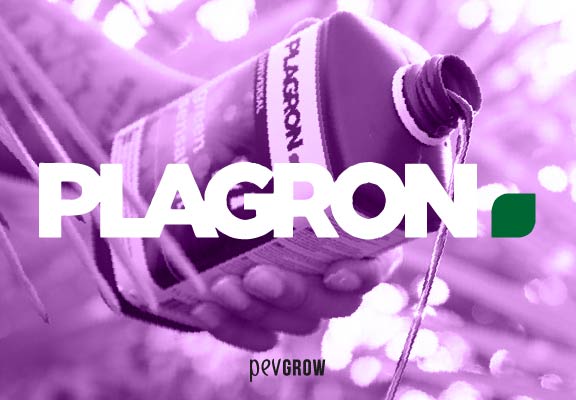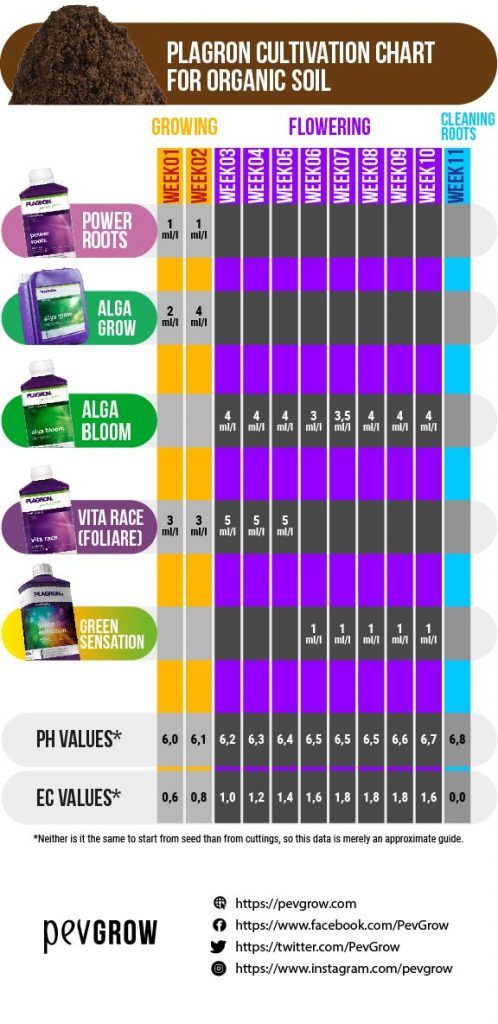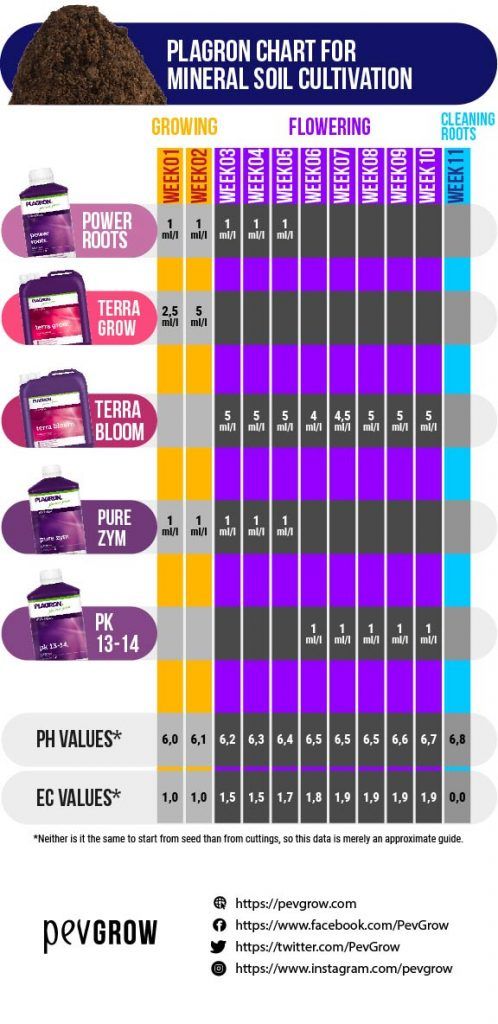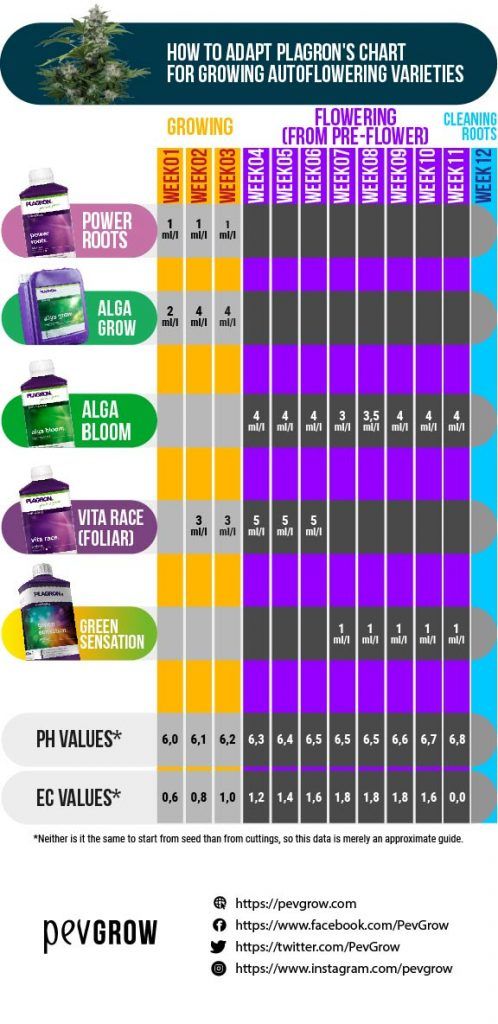

27-11-2020 10:00:35 - Updated: 27 November, 2020
Many growers ask us what is the ideal dosage of Plagron fertilizers? When should we start applying Green Sensation? With what PH? Do not worry, all these doubts are common when we start growing cannabis at home. Luckily the fertilizer brands provide us with watering charts, but it must be said that not all of them are identical, and there are some easier than others.
The Plagron growing chart is an informative graph where you can check the amount of fertilizers and additives to be added to the nutrient solution in each phase of cannabis cultivation. This guide makes our work much easier, but sometimes it is not easy to apply it accurately, so we think that this post can be useful for many people, because we are going to explain in detail how to use Plagron’s dosage schedule indoors and also for autoflowering varieties. Now you are interested, right? So go ahead…👍👉
These charts are created for indoor crops, with 2 weeks of vegetative growth and 9 weeks of flowering, where the last one is to clean the roots, so no food is added.
✨ Plagron cultivation chart for organic soil
Let’s start with the cultivation in soil in Bio mode, since it is the most extended, below I leave you a table where you can see the milliliters of the products that you have to mix with the irrigation in each week of the cycle:
| PHASE | ROOTED/ GROWING |
FLOWERING |
|---|---|---|
| POWER ROOTS | 1ml/l (1st,2nd week) | |
| ALGA GROW | 2ml/l (1st week) 4ml/l (2nd week) |
|
| ALGA BLOOM | 4ml/l (1st,2nd,3rd week) 3ml/l (4th week) 3,5ml/l (5th week) 4ml/l (6th,7th,8th week) |
|
| VITA RACE (foliar) | 3ml/l (1st,2nd week) | 5ml/l (1st,2nd,3rd week) |
| GREEN SENSATION | 1ml/l (4th,5th,6th,7th,8th week) |
You can see the ideal PH and EC values for this growing method, keep in mind that not all varieties eat the same, and neither is it the same to start from seed than from cuttings, so this data is merely an approximate guide.
| WEEKS > | Values PH | Values EC |
|---|---|---|
| 1 | 5,8 | 0,7 |
| 2 | 5,8 | 1,0 |
| 3 | 5,9 | 1,2 |
| 4 | 5,9 | 1,4 |
| 5 | 6,0 | 1,6 |
| 6 | 6,0 | 1,8 |
| 7 | 6,1 | 2,1 |
| 8 | 6,1 | 1,6 |
| 9 | 6,2 | 1,6 |
| 10 | 6,2 | 0,4 |
| 11 | 6,2 | 0,4 |
*The first 2 weeks correspond to the cycle of vegetative growth and the last 9 to flowering, but the last week of cultivation you do not have to add nutrients to the irrigation.

⭐ Plagron chart for mineral soil cultivation
The next most widely used growing method in indoor cannabis cultivation is soil with mineral fertilizers, it is quite similar to the previous one, but the products change. It is the system most used by commercial growers, or those who want to get a great performance without renouncing to quality.
In this case I have to tell you that it is necessary to use enzymes to eliminate accumulated salts from the substrate, as well as to wash the roots well before harvesting, I leave you our own tutorial chart.
| PHASE | ROOTED/ GROWING |
FLOWERING |
|---|---|---|
| POWER ROOTS | 1ml/l (1st,2nd week) | 1ml/l (1st,2nd,3rd week) |
| TERRA GROW | 2,5ml/l (1st week) 5 ml/l(2nd week) |
|
| TERRA BLOOM | 5ml/l (1st,2nd,3rd week) 4ml/l (4th week) 4,5ml/l (5th week) 5ml/l (6th,7th,8th week) |
|
| PURE ZYM | 1ml/l (1st,2nd week) | 1ml/l (1st,2nd,3rd week) |
| PK 13-14 | 1ml/l (4th,5th,6th,7th,8th week) |
You can see the ideal PH and EC values for this growing method, keep in mind that not all varieties eat the same, and neither is it the same to start from seed than from cuttings, so this data is merely an approximate guide.
| WEEKS > | Values PH | Values EC |
|---|---|---|
| 1 | 6,0 | 1,0 |
| 2 | 6,1 | 1,0 |
| 3 | 6,2 | 1,5 |
| 4 | 6,3 | 1,5 |
| 5 | 6,4 | 1,7 |
| 6 | 6,5 | 1,8 |
| 7 | 6,5 | 1,9 |
| 8 | 6,5 | 1,9 |
| 9 | 6,6 | 1,9 |
| 10 | 6,7 | 1,9 |
| 11 | 6,8 | 0 |
*The first 2 weeks correspond to the cycle of vegetative growth and the last 9 to flowering, but the last week of cultivation you do not have to add nutrients to the irrigation.

✅ Plagron irrigation program for coconut growing
Another type of cultivation substrate for potted cannabis is coconut fiber. It is very similar to soil, but it is inert, that is to say that it does not contain food, so it needs its specific fertilizers.
When growing in coconut remember to be very precise by adjusting the PH and EC, because in this substrate it is key for optimal plant development. It is also highly recommended to work with osmosis or very soft water in systems like this where you have to add all the food in liquid form. If the tap water in your area contains an EC higher than 0,5 I advise you to grow with distilled or osmosis water, and add calcium and magnesium until you reach a value of 0,4. Below you can see Plagron’s chart adapted to coconut cultivation:
| PHASE | ROOTED/ GROWING |
FLOWERING |
|---|---|---|
| POWER ROOTS | 1ml/l (1st,2nd week) | 1ml/l (1st,2nd,3rd week) |
| COCO A | 2ml/l (1st week) 2,5 ml/l(2nd week) |
3ml/l (1st week) 3,5 ml/l (2nd,3rd,4th,5th,6th,7th,8th week) |
| COCO B | 2ml/l (1st week) 2,5 ml/l(2nd week) |
3ml/l (1st week) 3,5 ml/l (2nd,3rd,4th,5th,6th,7th,8th week) |
| PURE ZYM | 1ml/l (1st,2nd week) | 1ml/l (1st,2nd,3rd week) |
| GREEN SENSATION O PK 13-14 | 1ml/l (4th,5th,6th,7th,8th week) |
You can see the ideal PH and EC values for this growing method, keep in mind that not all varieties eat the same, and neither is it the same to start from seed than from cuttings, so this data is merely an approximate guide.
| WEEKS > | Values PH | Values EC |
|---|---|---|
| 1 | 5,5 | 1,5 |
| 2 | 5,6 | 1,7 |
| 3 | 5,8 | 1,9 |
| 4 | 5,9 | 2,2 |
| 5 | 6,0 | 2,2 |
| 6 | 6,1 | 2,3 |
| 7 | 6,1 | 2,5 |
| 8 | 6,2 | 2,5 |
| 9 | 6,2 | 2,5 |
| 10 | 6,3 | 2,5 |
| 11 | 6,3 | 0 |
*The first 2 weeks correspond to the cycle of vegetative growth and the last 9 to flowering, but the last week of cultivation you do not have to add nutrients to the irrigation.

⚠️ Plagron fertilization calendar for hydroponics and aeroponics
The following table by Plagron is suitable for both hydroponic and aeroponic growing. As it happens with coconut cultivation, in the systems without soil it is necessary to be very careful with PH and EC measurements, and the water has to be soft, with a contribution of Ca and Mg until reaching 0,4 of EC, therefore I am going to leave you our adaptation of the graph for hydro cultivation by Plagron so that you can have a clearer picture:
| PHASE | ROOTED/ GROWING |
FLOWERING |
|---|---|---|
| POWER ROOTS | 1ml/l (1st,2nd week) | 1ml/l (1st,2nd,3rd week) |
| HYDRO A | 1,6ml/l (1st week) 1,8 ml/l(2nd week) |
2ml/l (1st week) 2,2 ml/l (2nd week) 2,5 ml/l (3rd week) 2,2 ml/l (4th week) 2,5 ml/l (5th,6th,7th,8th week) |
| HYDRO B | 1,6ml/l (1st week) 1,8 ml/l(2nd week) |
2ml/l (1st week) 2,2 ml/l (2nd week) 2,5 ml/l (3rd week) 2,2 ml/l (4th week) 2,5 ml/l (5th,6th,7th,8th week) |
| PURE ZYM | 1ml/l (1st,2nd week) | 1ml/l (1st,2nd,3rd week) |
| GREEN SENSATION O PK 13-14 | 1ml/l (4th,5th,6th,7th,8th week) |
You can see the ideal PH and EC values for this growing method, keep in mind that not all varieties eat the same, and neither is it the same to start from seed than from cuttings, so this data is merely an approximate guide.
| WEEKS > | Values PH | Values EC |
|---|---|---|
| 1 | 5,5 | 1,3 |
| 2 | 5,6 | 1,4 |
| 3 | 5,8 | 1,5 |
| 4 | 5,9 | 1,7 |
| 5 | 5,9 | 1,8 |
| 6 | 6,0 | 2,0 |
| 7 | 6,0 | 2,2 |
| 8 | 6,1 | 2,2 |
| 9 | 6,1 | 2,2 |
| 10 | 6,2 | 2,2 |
| 11 | 6,2 | 0 |
*The first 2 weeks correspond to the cycle of vegetative growth and the last 9 to flowering, but the last week of cultivation you do not have to add nutrients to the irrigation.

📲 How to adapt Plagron’s chart for growing autoflowering varieties
Many customers and friends ask us, “Can I grow autoflowering plants following Plagron’s chart?. The answer is yes, but there are some details to be considered. The average life cycle of an automatic flowering genetics is 80 days, a little more than the 11 weeks that are defined in the growing guide for standard strains by Plagron. But obviously, these tables show only 2 weeks of growth, when the cars grow from 3 to 4 weeks before beginning their bloom. We are going to calculate the blooming from the moment when the pre-flowers appear and we have adapted the graph to the autoflowering culture, here you can see it:
| PHASE | ROOTED/ GROWING |
FLOWERING |
|---|---|---|
| POWER ROOTS | 1ml/l (1st,2nd,3rd week) | |
| ALGA GROW | 2ml/l (1st week) 4 ml/l(2nd,3rd week) |
2ml/l (1st week) 2,2 ml/l (2nd week) 2,5 ml/l (3rd week) 2,2 ml/l (4th week) 2,5 ml/l (5th,6th,7th,8th week) |
| ALGA BLOOM | 4ml/l (1st,2nd,3rd week) 3ml/l (4th week) 3,5ml/l (5th week) 4ml/l (6th,7th,8th week) |
|
| VITA RACE (foliar) | 3ml/l (2nd,3rd week) | 5ml/l (1st,2nd,3rd week) |
| GREEN SENSATION | 1ml/l (4th,5th,6th,7th,8th week) |
| WEEKS > | Values PH | Values EC |
|---|---|---|
| 1 | 6,0 | 0,6 |
| 2 | 6,1 | 0,1 |
| 3 | 6,2 | 1,0 |
| 4 | 6,3 | 1,2 |
| 5 | 6,4 | 1,4 |
| 6 | 6,5 | 1,6 |
| 7 | 6,5 | 1,8 |
| 8 | 6,5 | 1,8 |
| 9 | 6,6 | 1,8 |
| 10 | 6,7 | 1,6 |
| 11 | 6,8 | 0 |

🚀 How can Sugar Royal be included in Plagron’s chart?
Here we have one of the great doubts about Plagron fertilizers, and that is that you only have to take a look at several pages in the sector to see that each one recommends administering this product in a different way. The manufacturer advises to start adding Sugar Royal to the irrigation from the second week of growth, others say from the second week of flowering and others when the plant starts to form buds.
If you look at its composition, you will see that this product is made up of nitrogen and amino acids, so you can start applying it from the growth phase without any problems, as recommended by the brand. However, it must be said that due to its high content of N, it is interesting to do a good root wash about 10 days before the harvest if this additive is used, because the plants are very green at the end of their cycle.
👌 Conclusion
Throughout this post we have seen the different ways to apply Plagron’s table for different cannabis growing systems. If you have any doubt about it, do not hesitate to ask in the comments and, if you have learned something new with this article, it would be nice if you share it, we thank you in advance.😜

